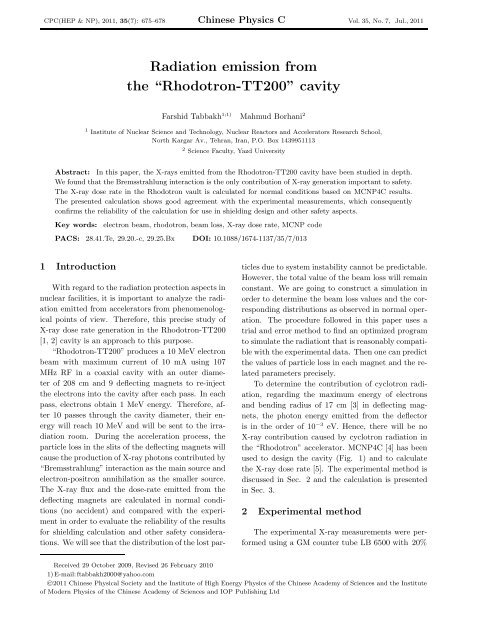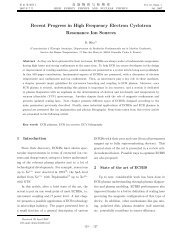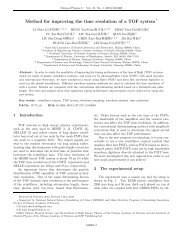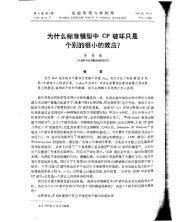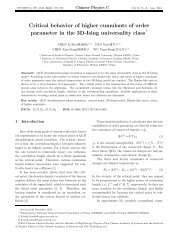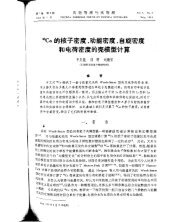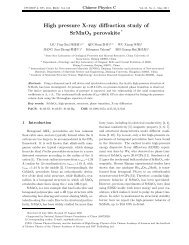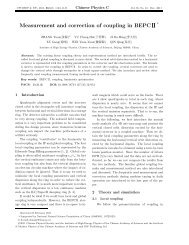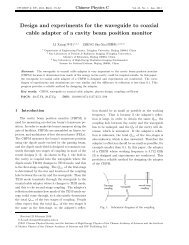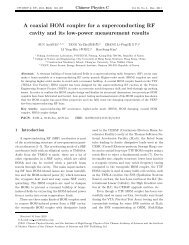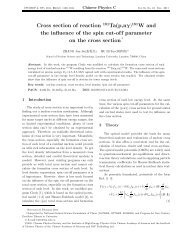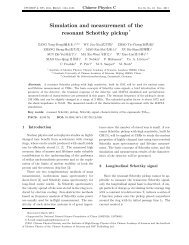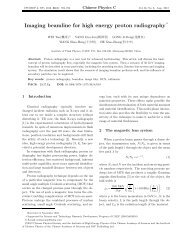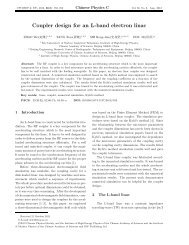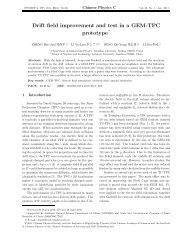Radiation emission from the âRhodotron-TT200â cavity
Radiation emission from the âRhodotron-TT200â cavity
Radiation emission from the âRhodotron-TT200â cavity
You also want an ePaper? Increase the reach of your titles
YUMPU automatically turns print PDFs into web optimized ePapers that Google loves.
CPC(HEP & NP), 2011, 35(7): 675–678 Chinese Physics C Vol. 35, No. 7, Jul., 2011<br />
<strong>Radiation</strong> <strong>emission</strong> <strong>from</strong><br />
<strong>the</strong> “Rhodotron-TT200” <strong>cavity</strong><br />
Farshid Tabbakh 1;1) Mahmud Borhani 2<br />
1 Institute of Nuclear Science and Technology, Nuclear Reactors and Accelerators Research School,<br />
North Kargar Av., Tehran, Iran, P.O. Box 1439951113<br />
2 Science Faculty, Yazd University<br />
Abstract: In this paper, <strong>the</strong> X-rays emitted <strong>from</strong> <strong>the</strong> Rhodotron-TT200 <strong>cavity</strong> have been studied in depth.<br />
We found that <strong>the</strong> Bremsstrahlung interaction is <strong>the</strong> only contribution of X-ray generation important to safety.<br />
The X-ray dose rate in <strong>the</strong> Rhodotron vault is calculated for normal conditions based on MCNP4C results.<br />
The presented calculation shows good agreement with <strong>the</strong> experimental measurements, which consequently<br />
confirms <strong>the</strong> reliability of <strong>the</strong> calculation for use in shielding design and o<strong>the</strong>r safety aspects.<br />
Key words:<br />
electron beam, rhodotron, beam loss, X-ray dose rate, MCNP code<br />
PACS: 28.41.Te, 29.20.-c, 29.25.Bx DOI: 10.1088/1674-1137/35/7/013<br />
1 Introduction<br />
With regard to <strong>the</strong> radiation protection aspects in<br />
nuclear facilities, it is important to analyze <strong>the</strong> radiation<br />
emitted <strong>from</strong> accelerators <strong>from</strong> phenomenological<br />
points of view. Therefore, this precise study of<br />
X-ray dose rate generation in <strong>the</strong> Rhodotron-TT200<br />
[1, 2] <strong>cavity</strong> is an approach to this purpose.<br />
“Rhodotron-TT200” produces a 10 MeV electron<br />
beam with maximum current of 10 mA using 107<br />
MHz RF in a coaxial <strong>cavity</strong> with an outer diameter<br />
of 208 cm and 9 deflecting magnets to re-inject<br />
<strong>the</strong> electrons into <strong>the</strong> <strong>cavity</strong> after each pass. In each<br />
pass, electrons obtain 1 MeV energy. Therefore, after<br />
10 passes through <strong>the</strong> <strong>cavity</strong> diameter, <strong>the</strong>ir energy<br />
will reach 10 MeV and will be sent to <strong>the</strong> irradiation<br />
room. During <strong>the</strong> acceleration process, <strong>the</strong><br />
particle loss in <strong>the</strong> slits of <strong>the</strong> deflecting magnets will<br />
cause <strong>the</strong> production of X-ray photons contributed by<br />
“Bremsstrahlung” interaction as <strong>the</strong> main source and<br />
electron-positron annihilation as <strong>the</strong> smaller source.<br />
The X-ray flux and <strong>the</strong> dose-rate emitted <strong>from</strong> <strong>the</strong><br />
deflecting magnets are calculated in normal conditions<br />
(no accident) and compared with <strong>the</strong> experiment<br />
in order to evaluate <strong>the</strong> reliability of <strong>the</strong> results<br />
for shielding calculation and o<strong>the</strong>r safety considerations.<br />
We will see that <strong>the</strong> distribution of <strong>the</strong> lost particles<br />
due to system instability cannot be predictable.<br />
However, <strong>the</strong> total value of <strong>the</strong> beam loss will remain<br />
constant. We are going to construct a simulation in<br />
order to determine <strong>the</strong> beam loss values and <strong>the</strong> corresponding<br />
distributions as observed in normal operation.<br />
The procedure followed in this paper uses a<br />
trial and error method to find an optimized program<br />
to simulate <strong>the</strong> radiationt that is reasonably compatible<br />
with <strong>the</strong> experimental data. Then one can predict<br />
<strong>the</strong> values of particle loss in each magnet and <strong>the</strong> related<br />
parameters precisely.<br />
To determine <strong>the</strong> contribution of cyclotron radiation,<br />
regarding <strong>the</strong> maximum energy of electrons<br />
and bending radius of 17 cm [3] in deflecting magnets,<br />
<strong>the</strong> photon energy emitted <strong>from</strong> <strong>the</strong> deflector<br />
is in <strong>the</strong> order of 10 −3 eV. Hence, <strong>the</strong>re will be no<br />
X-ray contribution caused by cyclotron radiation in<br />
<strong>the</strong> “Rhodotron” accelerator. MCNP4C [4] has been<br />
used to design <strong>the</strong> <strong>cavity</strong> (Fig. 1) and to calculate<br />
<strong>the</strong> X-ray dose rate [5]. The experimental method is<br />
discussed in Sec. 2 and <strong>the</strong> calculation is presented<br />
in Sec. 3.<br />
2 Experimental method<br />
The experimental X-ray measurements were performed<br />
using a GM counter tube LB 6500 with 20%<br />
Received 29 October 2009, Revised 26 February 2010<br />
1) E-mail: ftabbakh2000@yahoo.com<br />
©2011 Chinese Physical Society and <strong>the</strong> Institute of High Energy Physics of <strong>the</strong> Chinese Academy of Sciences and <strong>the</strong> Institute<br />
of Modern Physics of <strong>the</strong> Chinese Academy of Sciences and IOP Publishing Ltd
676 Chinese Physics C (HEP & NP) Vol. 35<br />
accuracy. To omit <strong>the</strong> X-ray effects emitted <strong>from</strong><br />
beam line components such as <strong>the</strong> 270 ◦ bending magnet,<br />
we shielded those components with lead bricks.<br />
O<strong>the</strong>rwise, we would not be able distinguish between<br />
“Rhodotron” and beam line component radiation.<br />
Due to <strong>the</strong> intrinsic instability of <strong>the</strong> system and<br />
also to maximize <strong>the</strong> accuracy of <strong>the</strong> results, <strong>the</strong> dose<br />
rate corresponding to each magnet was measured over<br />
three different days. The average values are taken as<br />
<strong>the</strong> standard values for comparison with <strong>the</strong> simulation<br />
results. The average beam loss current obtained<br />
<strong>from</strong> <strong>the</strong> system indicators is as much as 229 µA with<br />
an error of 5%, which is in good agreement with <strong>the</strong><br />
values discussed in Refs. [6, 7]. The o<strong>the</strong>r parameter<br />
that should be included in <strong>the</strong> accuracy measurement<br />
is beam stability. According to <strong>the</strong> system<br />
specification, <strong>the</strong> accuracy of <strong>the</strong> beam is considered<br />
to be as much as 5%. The head of <strong>the</strong> detector was<br />
placed 25 cm <strong>from</strong> <strong>the</strong> magnets with <strong>the</strong> same distances<br />
<strong>from</strong> each slit. The detector position and <strong>the</strong><br />
distance to <strong>the</strong> magnet L are shown in Fig. 1. Since<br />
<strong>the</strong> accuracy of <strong>the</strong> detector position can be ignored,<br />
<strong>the</strong> total accuracy corresponding to <strong>the</strong> experimental<br />
measurements will be as large as 30%. The obtained<br />
experimental data are shown and compared with <strong>the</strong><br />
calculation results in Figs. 3 and 4.<br />
Fig. 1. Horizontal cross section of <strong>the</strong> <strong>cavity</strong>,<br />
designed by MCNP. Point “A” represents <strong>the</strong><br />
beginning of <strong>the</strong> 10 MeV beam line.<br />
3 Calculation and results<br />
Due to <strong>the</strong> continuous beam injection and <strong>the</strong><br />
space charge effects [6, 7], during <strong>the</strong> acceleration process,<br />
an unwanted fraction of electrons will be lost in<br />
<strong>the</strong> <strong>cavity</strong> and deflector slits. These particles will<br />
hit <strong>the</strong> <strong>cavity</strong> body at <strong>the</strong> beam exit in particular<br />
or in <strong>the</strong> entrance slits of <strong>the</strong> deflectors and generate<br />
X-rays via Bremsstrahlung. Therefore, <strong>the</strong> dose<br />
rate value of <strong>the</strong> photons will be very important to<br />
safety. To obtain comparable results to <strong>the</strong> experimental<br />
values, <strong>the</strong> average value of beam loss (229<br />
µA) is considered as <strong>the</strong> radiation source in <strong>the</strong> simulation.<br />
In addition, calculations are performed for<br />
<strong>the</strong> point corresponding to <strong>the</strong> detector position, as<br />
explained in <strong>the</strong> experimental method in <strong>the</strong> previous<br />
section.<br />
The MCNP4C results have errors of less than 5%,<br />
using tally F5. The “SDEF” card is defined for 19<br />
source positions (18 sources representing 9 magnets<br />
slits and one representing <strong>the</strong> slits of <strong>the</strong> outgoing 10<br />
MeV beam line). The probability of <strong>the</strong> distribution<br />
is considered as equal as first and <strong>the</strong>n, finally, <strong>the</strong>se<br />
probabilities are optimized in order to give <strong>the</strong> same<br />
conditions as in experiment.<br />
According to <strong>the</strong> MCNP output data for predicting<br />
<strong>the</strong> photons’ average energy, by dividing <strong>the</strong><br />
weighted energy created (6.0415×10 −01 MeV) by <strong>the</strong><br />
total weight of photons produced (6.6673×10 −01 ), one<br />
can conclude that <strong>the</strong> X-ray average energy in <strong>the</strong><br />
vault is near 0.9 MeV.<br />
Figure 2 shows <strong>the</strong> MCNP results assuming that<br />
<strong>the</strong> particle losses in <strong>the</strong> magnets are distributed<br />
equally. In this figure <strong>the</strong> total photon flux emitted<br />
<strong>from</strong> each magnet over 5 different distances is<br />
presented. In those magnets with a lower number,<br />
<strong>the</strong> electrons with lower energy interact and produce<br />
photons. However, increasing <strong>the</strong> beam energy will<br />
increase <strong>the</strong> number of Bremsstrahlung interactions.<br />
Consequently, as illustrated by this figure, increasing<br />
<strong>the</strong> number of magnets will increase <strong>the</strong> represented<br />
photon flux. In addition, <strong>the</strong> values representing<br />
Mag. 1 and Mag. 8 are higher than <strong>the</strong> expected<br />
values, which refer to <strong>the</strong> effects caused by <strong>the</strong><br />
10 MeV out-going slit at <strong>the</strong> start of <strong>the</strong> beam tube<br />
(Point “A” in Fig. 1). Since most of <strong>the</strong> photons are<br />
emitted upwards or backwards along <strong>the</strong> beam direction,<br />
decreasing <strong>the</strong> distance to Magnet No. 1 and<br />
No. 8 will decrease <strong>the</strong> photon contribution emitted<br />
<strong>from</strong> point “A”. Therefore, <strong>the</strong> line represented by<br />
L=10 cm is smoo<strong>the</strong>r than <strong>the</strong> o<strong>the</strong>r lines.<br />
Figure 3 shows both <strong>the</strong> simulation and experimental<br />
values of <strong>the</strong> dose rate at a distance of 25 cm<br />
as <strong>the</strong> reference point <strong>from</strong> <strong>the</strong> magnets. The simulation<br />
presented in this figure is performed for <strong>the</strong><br />
equal distribution of beam loss in all <strong>the</strong> magnets<br />
(called <strong>the</strong> ideal source), which is equivalent to <strong>the</strong><br />
line L=25 cm in Fig. 2. Opposite to <strong>the</strong> ideal source,<br />
<strong>the</strong>re is unequal distribution of beam loss in <strong>the</strong>
No. 7 Farshid Tabbakh et al: <strong>Radiation</strong> <strong>emission</strong> <strong>from</strong> <strong>the</strong> “Rhodotron-TT200” <strong>cavity</strong> 677<br />
Fig. 2. MCNP results for photon flux with respect<br />
to each magnet (X-ray sources) for different<br />
distances.<br />
magnets represented by circle symbols showing <strong>the</strong><br />
experimental values with a total accuracy of 30% discussed<br />
in Sec. 2. As illustrated in this figure and due<br />
to <strong>the</strong> reasons mentioned above, reducing <strong>the</strong> beam<br />
loss in Magnets 7 and 9 will cause <strong>the</strong> measured values<br />
to drop to smaller ones than expected. Leaning on<br />
pure experimental data cannot give <strong>the</strong> particle loss<br />
value in <strong>the</strong> magnets except by referring to <strong>the</strong> calculation<br />
results also. The output data, as we mentioned,<br />
declare that <strong>the</strong> average energy belongs to 1 MeV<br />
photons. Therefore, <strong>from</strong> this figure <strong>the</strong> measured<br />
dose rates are 2.25×10 4 mSv/h and 2.2×10 4 mSv/h.<br />
Using <strong>the</strong> flux-to-dose rate conversion factors [5] for<br />
1MeV photons, we estimate that <strong>the</strong> emitted photon<br />
flux <strong>from</strong> Magnets 7 and 9 as 1.25×10 9 and 1.1×10 9<br />
photon/cm 2 /s, respectively, with 30% of accuracy. To<br />
confirm this, we have to modify <strong>the</strong> sources in MCNP<br />
to achieve <strong>the</strong> experimental values and <strong>the</strong>n calculate<br />
<strong>the</strong> related flux as discussed in Fig. 4.<br />
Figure 4 shows <strong>the</strong> dose rate after modifying <strong>the</strong><br />
probability distribution of <strong>the</strong> source in <strong>the</strong> input file.<br />
The square and circle symbols represent <strong>the</strong> MCNP<br />
and experimental data, respectively. Such a modification<br />
of <strong>the</strong> source card will lead to obtaining results<br />
comparable to <strong>the</strong> experimental data.<br />
The corresponding flux to Magnets 7 and 9<br />
according to MCNP in this figure is 1.3×10 9<br />
photon/cm 2 /s and 8.7×10 8 photon/cm 2 /s, respectively,<br />
which are close to what is extracted <strong>from</strong> Fig.<br />
3. In o<strong>the</strong>r words, <strong>the</strong> experimental and modified<br />
output data show an agreement of results.<br />
Referring to <strong>the</strong> total particle loss (229 µA) on <strong>the</strong><br />
one hand and obtaining <strong>the</strong> agreeable dose rate when<br />
<strong>the</strong> beam only hits <strong>the</strong> slits on <strong>the</strong> o<strong>the</strong>r, reconfirms<br />
our assumption that <strong>the</strong>re is no considerable loss inside<br />
<strong>the</strong> <strong>cavity</strong>.<br />
Figure 5 presents <strong>the</strong> energy distribution of <strong>the</strong><br />
photons emitted <strong>from</strong> Magnets No. 1 and No. 9 with<br />
Fig. 4. Experimental measurement (real condition)<br />
and calculation results of dose rate after<br />
<strong>the</strong> source modifications at a distance of 25<br />
cm <strong>from</strong> <strong>the</strong> magnets.<br />
Fig. 3. Experimental measurement (real condition)<br />
and calculation results (ideal condition)<br />
of dose rate at a distance of 25 cm <strong>from</strong> <strong>the</strong><br />
magnets.<br />
Fig. 5. Energy distribution of photons emitted<br />
<strong>from</strong> <strong>the</strong> magnets 1 and 9.
678 Chinese Physics C (HEP & NP) Vol. 35<br />
a peak at 1 MeV that certifies <strong>the</strong> value obtained previously.<br />
In this figure, although Magnet No. 1, emits<br />
photons with a maximum energy of 1 MeV, due to<br />
<strong>the</strong> o<strong>the</strong>r sources’ affects, one can observe <strong>the</strong> energy<br />
range <strong>from</strong> a few keV to almost 6 MeV and so is <strong>the</strong><br />
case with <strong>the</strong> o<strong>the</strong>r magnets. The spectra corresponding<br />
to <strong>the</strong> o<strong>the</strong>r magnets will lie between <strong>the</strong>se two<br />
lines with <strong>the</strong> same maximum energy of 1 MeV.<br />
4 Conclusion and discussion<br />
We have calculated <strong>the</strong> flux and dose rate distribution<br />
of an X-ray in a vault caused by particle loss<br />
in <strong>the</strong> <strong>cavity</strong> (<strong>the</strong> magnet slits). We understand that<br />
<strong>the</strong>re are no o<strong>the</strong>r considerable sources contributing<br />
to <strong>the</strong> dose rate in <strong>the</strong> accelerator, ignoring <strong>the</strong> photons<br />
emitted <strong>from</strong> <strong>the</strong> beam line 270 ◦ deflecting magnet.<br />
Here, we have to emphasize that <strong>the</strong> nature<br />
of this problem is statistical, which means that we<br />
cannot ensure that <strong>the</strong>re is no particle loss in <strong>the</strong><br />
o<strong>the</strong>r components of <strong>the</strong> accelerator body, but <strong>the</strong><br />
results confirm that <strong>the</strong> main part of <strong>the</strong> radiation<br />
in safety aspects is what we have calculated and <strong>the</strong><br />
particle loss in o<strong>the</strong>r parts of <strong>the</strong> <strong>cavity</strong> can be neglected.<br />
Therefore, <strong>the</strong> particles which may hit <strong>the</strong><br />
inner cylinder of <strong>the</strong> <strong>cavity</strong> will have no contribution<br />
to <strong>the</strong> X-ray <strong>emission</strong> because <strong>the</strong> <strong>cavity</strong> will shield<br />
such a small number of photons.<br />
In this paper, <strong>the</strong> calculations were performed<br />
by supposing that all 9 deflecting magnets are well<br />
tuned and that <strong>the</strong> beam loss is distributed between<br />
<strong>the</strong>m equally (ideal condition). To achieve a simulation<br />
comparable to <strong>the</strong> experiment, we performed<br />
our calculation including <strong>the</strong> modified fractions of<br />
particle loss in each slit (real condition). Now, after<br />
obtaining <strong>the</strong> prediction method using MCNP code,<br />
we can attempt to calculate <strong>the</strong> shielding design and<br />
o<strong>the</strong>r safety purposes for <strong>the</strong> “Rhodotron” accelerator,<br />
which is under development.<br />
References<br />
1 Pattier J. A New Type of RF Electron Accelerator: The<br />
Rhodotron. Nucl. Instrum. Methods. Phys. Res., 1989,<br />
B40/41: 943–945<br />
2 Umiastovski K et al. Rhodotron: an Accelerator for Industrial<br />
Irradiation. In: Proc. 2 nd European Conf. on Accelerator<br />
in Applied Res. and Tech. Frankfurt, Germany. 1991<br />
3 Tabbakh F. Chinese Physics C. 2009, 33(10): 1–4<br />
4 OAK Ridge National Laboratory. Monte Carlo N-Particle<br />
Transport Code System (MCNP4C). Los Alamos National<br />
Laboratory, 2000<br />
5 ANSI/ANS-6.1.1. Neutron and Gamma Fluence-to-Dose<br />
Factors. American Nuclear Society, 1991<br />
6 Gal O, Bassaler J M. Numerical and Experimental Results<br />
on <strong>the</strong> Beam Dynamic in <strong>the</strong> Rhodotron Accelerator. In:<br />
EPAC1992. 819–821<br />
7 Jongen Y, Abs M, Defrise D et al. First Beam Test Results<br />
of <strong>the</strong> 10 MeV, 100 kW Rhodotron. In: EPAC1994.<br />
527–529


